I have a 9.5k amp sitting here not sure of the name of it since there are no markings anywhere .
I will take pics once I get home of the board .
Just wondering what would cause the rail caps to blow replace them all seems fine a week down the road they blow again .
I know some of these Korean amps are know for blowing the rail caps repeatedly.
Anyone have any ideas ?
I will take pics once I get home of the board .
Just wondering what would cause the rail caps to blow replace them all seems fine a week down the road they blow again .
I know some of these Korean amps are know for blowing the rail caps repeatedly.
Anyone have any ideas ?
Ok I can’t think tonight.
How do I determine if that caps are on the positive or the negative rail ?
How do I determine if that caps are on the positive or the negative rail ?
One terminal of all of the rail caps goes to ground. The other terminal will either have positive OR negative rail voltage on them.
I have no clue what this amp is like but on many amps, the failure of the caps on only one rail is due to the failure of the drive circuit for the FETs on the same rail.
The rail voltage in this amp at idle is +- 217 volts .
The rail caps are rated for 220 volts .
So wondering once you start running the amp at high volumes is this why the rail caps are blowing since the rail voltage might increase somewhat ?
Wondering if the voltage for the caps is to low and should be replaced with a higher voltage cap or these caps should be fine ?
The rail caps are rated for 220 volts .
So wondering once you start running the amp at high volumes is this why the rail caps are blowing since the rail voltage might increase somewhat ?
Wondering if the voltage for the caps is to low and should be replaced with a higher voltage cap or these caps should be fine ?
Didn't you say that the caps were only failing on one rail?
The rated voltage is typically the rated voltage. The surge voltage is a bit higher.
The rail voltage typically drops. It doesn't go higher unless the 12v voltage goes higher. For amps that run as close as this amp, the voltage is sometimes regulated.
Post a good quality photo of the component side of the entire main board and the component side of any driver boards.
The rated voltage is typically the rated voltage. The surge voltage is a bit higher.
The rail voltage typically drops. It doesn't go higher unless the 12v voltage goes higher. For amps that run as close as this amp, the voltage is sometimes regulated.
Post a good quality photo of the component side of the entire main board and the component side of any driver boards.
My power supply is at 13 volts so when the amp is powered up and idling the battery voltage is 13 volts and the rail voltage is +- 217 volts .
The guy stated these amps will run on 16 volts and his voltage is a 15.8 volts at idle . So he has almost 16 volts i only have 13 volts when testing .
Here are some pics of the board let me know if you need more
So wondering since he is running the amp at 16 volts does this increase the rail voltage ?
The guy stated these amps will run on 16 volts and his voltage is a 15.8 volts at idle . So he has almost 16 volts i only have 13 volts when testing .
Here are some pics of the board let me know if you need more
So wondering since he is running the amp at 16 volts does this increase the rail voltage ?
Attachments
-
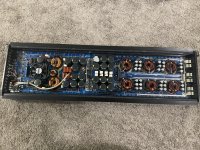 F1681488-0B38-47FC-837F-0D90CCAFE394.jpg1.1 MB · Views: 88
F1681488-0B38-47FC-837F-0D90CCAFE394.jpg1.1 MB · Views: 88 -
 9E5DEEE1-2CE2-4B90-8F8D-ABE6BF0508F4.jpg1.1 MB · Views: 83
9E5DEEE1-2CE2-4B90-8F8D-ABE6BF0508F4.jpg1.1 MB · Views: 83 -
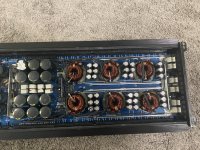 F9352165-01FF-4AAD-A719-00CC3ACFBE65.jpg1.1 MB · Views: 98
F9352165-01FF-4AAD-A719-00CC3ACFBE65.jpg1.1 MB · Views: 98 -
 80484968-2672-45DA-863F-BCCFA9AADCA3.jpg1 MB · Views: 93
80484968-2672-45DA-863F-BCCFA9AADCA3.jpg1 MB · Views: 93 -
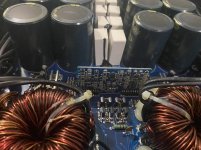 E4C42C15-ABAA-4A1C-914C-0D9EB57EC4DC.jpg997.2 KB · Views: 73
E4C42C15-ABAA-4A1C-914C-0D9EB57EC4DC.jpg997.2 KB · Views: 73 -
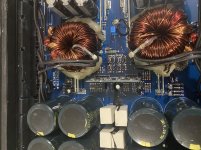 6CC23CFB-2620-427F-A722-4EAF21F2C662.jpg1,018.5 KB · Views: 64
6CC23CFB-2620-427F-A722-4EAF21F2C662.jpg1,018.5 KB · Views: 64 -
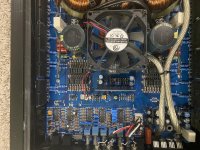 D27DDB18-737A-4FD1-9E6C-A441FB01AEA6.jpg1 MB · Views: 68
D27DDB18-737A-4FD1-9E6C-A441FB01AEA6.jpg1 MB · Views: 68 -
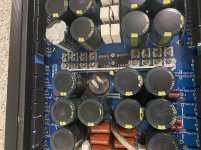 1114B9D7-38B4-4CE5-978B-72CA9351E463.jpg1,011.3 KB · Views: 96
1114B9D7-38B4-4CE5-978B-72CA9351E463.jpg1,011.3 KB · Views: 96
If this is not regulated power supply (I think it is not regulated) at 16volts the rail voltage would much much more than the voltage rating of the caps. They wouldn't blow instantly but in time surely will.
And Samwha aren't the best caps either...
If you have a laboratory power supply you can increase the voltage up to 16v to see what are the rail voltages....
But all of this doesn't make sense if only one of the rails is blowing caps.
And Samwha aren't the best caps either...
If you have a laboratory power supply you can increase the voltage up to 16v to see what are the rail voltages....
But all of this doesn't make sense if only one of the rails is blowing caps.
Terminals for power and ground wires ?
If so it has 3 battery plus terminals and 3 ground terminals a total of 6.
If you mean the power supply driver board it has 16 terminals
If so it has 3 battery plus terminals and 3 ground terminals a total of 6.
If you mean the power supply driver board it has 16 terminals
I don't know about the 16 terminal board. The 11 terminal boards aren't regulated. The 14 terminal boards are regulated.
As was previously stated in post 11, you can adjust the 12v supply voltage to see if the rail voltage changes.
As was previously stated in post 11, you can adjust the 12v supply voltage to see if the rail voltage changes.
Now that I took out the other cap that was replaced at once point the rail voltage dropped to 163 volts . Not sure why .
The only caps that were blown in this amp were on the negative rail .
The only caps that were blown in this amp were on the negative rail .
- Home
- General Interest
- Car Audio
- Korean amp question